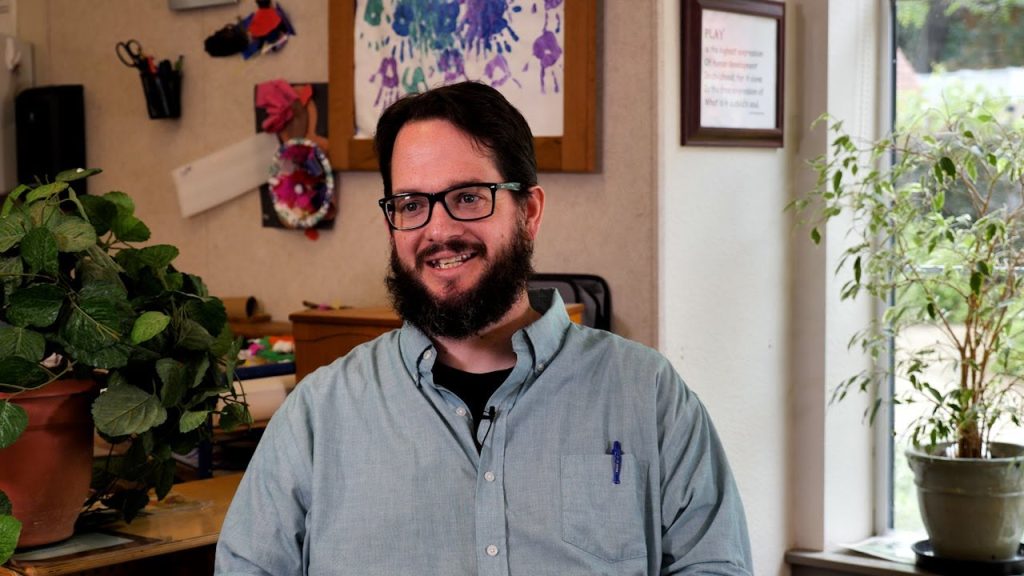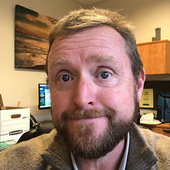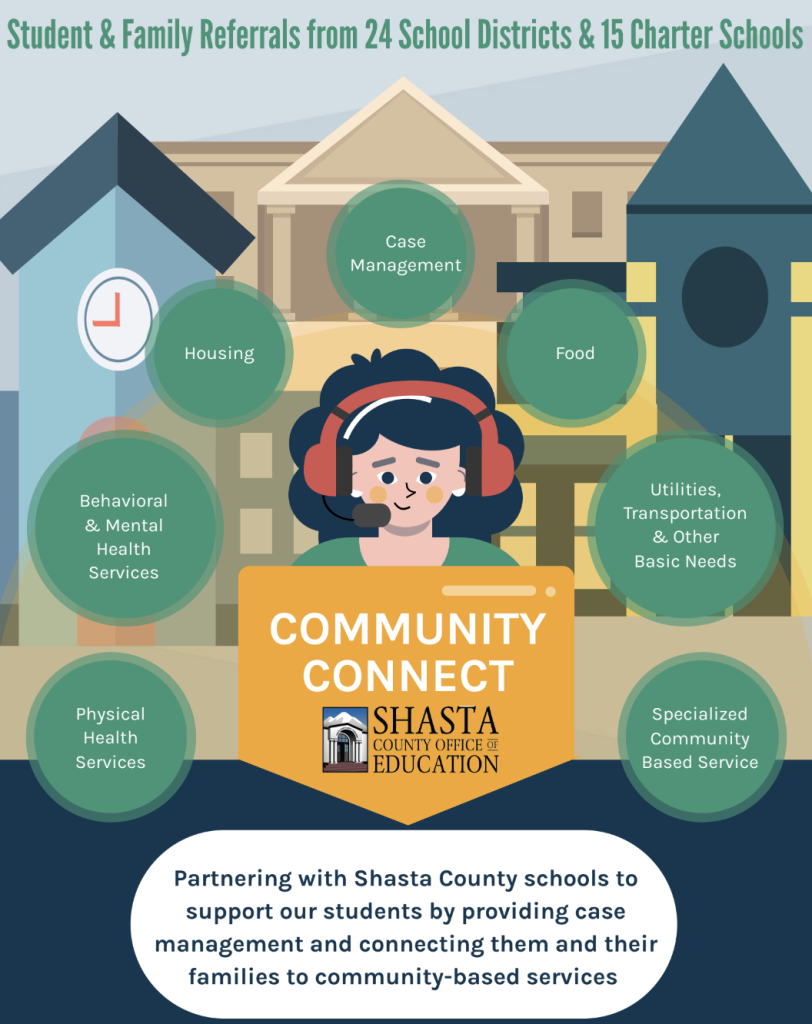Ripples of Success:

Arrival in Redding
Twelve years ago, Shaw Tiefenbach’s car broke down. He and his children rode a bus into Redding, California, a small town four hours north of San Francisco. He wasn’t planning on coming here; it was the only place the bus would take him and he had nowhere else to go. No one sets out to live in a motel, but as his daughter’s birthday approached, he felt like he’d lost all hope. He needed help. He needed his community. The first connection to the community was through a social worker who, from the very beginning, displayed a profound level of care and commitment:
Shaw: We stayed at a hotel one night for my daughter’s birthday. A Social Worker happened to be there. My daughter’s like, “Oh, it’s my birthday,” and she called us that night. It’s like, “Hey, do you need a cake? Do you need presents or anything?” And she was an advocate. She ended up finding us an apartment. And then from there, I felt I really needed an education… And I don’t know, the rest was kind of history. I kept going to school and trying to better myself and my situation.

Specifically, Shaw signed up for his first Early Childhood Education (ECE) class at Shasta College. This would be the first of many. He would eventually come out of his shell and open up to the idea of teaching preschool students, but then and there, sitting in his first ECE class, he was overcome by his shyness. By his own estimation, he was an introvert unsure if he could complete this class. They asked for volunteers in the Shasta College Lab School with its own ECE program:
Shaw: I remember hearing a teacher kind of say you want to get the most out of this experience and at the time I was very shy, very introverted; [I would normally] shy away from participating, I guess, kind of just go to school, go home and that was it. I was in my first ECE class, and then they’re like, “Anyone would like to volunteer in the ECE lab school?” And I rose my hand reluctantly, try it out, I always liked kids. And from there I loved it, you know, twenty something ECE classes after that kind of shifted my focus a little bit. And that’s what got me started.
Aaron: What’s the lab?
Shaw: So it’s the Shasta College Lab School. They had an ECE program there, on-site [at the] preschool and a lot of mentor teachers; you’re able to learn from them and work with children. A lot of classes, observations, so you’re in there learning how to observe for different domains or different things; you focus on one child and kind of see what that’s like.
It took a lot of work and a lot of help for Shaw to start a new career from the ground up, and he’s come a long way in twelve years. What sparked the flame of Shaw’s compassion? Was it the trials he endured when he arrived in Redding? The support of the social worker? The push from his teacher?”
The Spark of Change
Shaw Tiefenbach is currently an Associate Marriage and Family Therapist with the Shasta County Office of Education (SCOE), and he’s working with Community Connect as an Infant Early Childhood Mental Health Consultant. A recent addition to Shasta County, Community Connect partners with families to connect them with the support they need to help students get back on track. In this department, Shaw helps families who need extra support with resources at the earliest possible opportunity.
It took a lot of work and a lot of help for Shaw to start a new career from the ground up, and he’s come a long way in twelve years. What sparked the flame of Shaw’s compassion? Was it the trials he endured when he arrived in Redding? The support of the social worker? The push from his teacher? Shaw indicates that it was all of these combined with his own passion for caregiving:
Shaw: I love being a dad; it’s not the gender norm, I guess, but I’ve always been kind of nurturing and really relish that role. Being homeless… you see children and parents struggling and you see the adversity and coming to Shasta County, learning that we’re, you know, some of the highest [areas] with [young people experiencing] adverse childhood experiences. It was all that [and] more motivating me to do something, to help and support them.
Through his education and personal experiences, Shaw learned that the whole family must be involved when supporting youth who experience difficulty.”
This start to family growth set the stage for his transition into family therapy. Maybe he didn’t think of it in these terms from the beginning, but Shaw has since realized family therapy was always his goal:
Shaw: Family therapist was my goal in the beginning. I wasn’t sure if I wanted to be a social worker or a therapist, but my logical way of thinking about it was that you need a certain level of education to teach preschool or even to be an aide. I think it was like twelve units. And then, to be a therapist or social worker, you need a master’s degree. We had to do a vision board or a vision statement. And so in that statement, we laid out what we wanted to do. And I did want to work for Bridges [SCOE program that provides evidence-based mental healthcare to students, families, and schools]. They came in and talked to us before [so I was] familiar with them a little bit. That was in 2012. So I figured if I have the experience in the classroom, [learn] what it’s like to teach, that when and if I get that position with Bridges, then I’ll have that understanding of what the teachers are going through and the experiences with children, talking with and supporting parents and things like that.
Through his education and personal experiences, Shaw learned that the whole family must be involved when supporting youth who experience difficulty. This is particularly true for children who experience Adverse Childhood Experiences (ACEs), which are potentially traumatic events that occur in childhood. Family substance abuse, verbal and physical abuse, and witnessed domestic violence are examples of ACEs, and these adverse experiences have a profound impact on the child. Arriving at Redding without a home to live in is one such experience that can harm a child’s development, and Shaw has utilized resources that Shasta County offers to mitigate the adverse consequences of housing instability, to raise the standard of living for his own family, and to support other families experiencing similar difficulties.
Shaw’s work now spans individual and family therapy including the Triple P Parenting Program. Beginning in Australia over 30 years ago, Triple P has been offered in SCOE for over 15 years. The program offers support for parents who may be experiencing insecurities about raising their children through an eight-week program that emphasizes self-reflection and offers parents alternatives to traditional discipline techniques. This Positive Parenting Program empowers parents to confidently manage their children’s behavior and has been backed by over 30 years of experience.
But it’s only one tool Shaw offers families. Shaw also assists teachers with classroom management, each role informed by his early experiences as a parent and a desire to mend the fabric of family and community life.
The program offers support for parents who may be experiencing insecurities about raising their children through an eight-week program that emphasizes self-reflection and offers parents alternatives to traditional discipline techniques.”
Bridges to Success

Shaw unfortunately wasn’t the only person in Redding experiencing challenges raising his children. Shasta County families experience these hardships twice as often as the rest of California, according to a CDC Behavioral Risk Factor Surveillance System (BRFSS) study conducted over the past decade. SCOE began working to address this reality over 20 years ago, and this work has grown into SCOE’s Bridges to Success program, generally referred to as Bridges. When a child needs assistance in the school, Bridges will receive a referral. Perhaps a child is experiencing difficulties related to an ACE and is acting out in school; perhaps a child isn’t thriving as they once did. Shaw works with the child and the parents to find a solution:
Shaw: Bridges, that’s the name of our program. We do an 8-week consultation model. So basically we get a referral from the school, or maybe there are behaviors in the classroom that are disrupting their learning, or the learning of others. And maybe the schools have tried everything that they can on their side. So we go in and are there to support them in their plan. I’m not there to tell them what to do, but to help them reflect and really collaborate with them; another set of eyes in the classroom. Oftentimes too, if at the end of the 8-week models, if we’re still finding that they need more support, then that’s when we might offer other intensive services like family therapy, individual therapy, or we also do EMDR (Eye Movement Desensitization and Reprocessing; a specific treatment for PTSD) which helps with trauma. Or we also might offer Triple P parenting classes, depending on what they need.
The goal is to find a consistent way to respond to a problem differently. Individuals who experience trauma often have overactive fight or flight responses, so Shaw helps children calm this response and manage their feelings in situations where the fight or flight response is not helpful or needed. The fight or flight response can look different from child to child. It’s normal for a child to test boundaries, but a child who has experienced trauma may hide in a shadowy corner or withdraw from a positive experience they previously enjoyed. If given the chance, the child may elope from the classroom entirely or, in extreme cases, cause harm to another person. Addressing these issues begins with the family as a whole. Shaw and the Bridges team support parents in addressing their own trauma, and give them tools to support their children in learning how to manage emotions. In order to do this work, Bridges utilizes everything from in-house therapy and online parental training to brain mapping, to train and empower new community therapists every year.
Shaw and the Bridges team support parents in addressing their own trauma, and give them tools to support their children in learning how to manage emotions.”
The Power of Positive Discipline
Shaw works with the parents and guardians to keep them from parenting out of fear and anger. Sometimes parents try to drop off the children for therapy without wanting to involve themselves in the process:
Shaw: [The] problem is children don’t hold a lot of power. It’s the parents that really make the difference, and [often] that comes from generational trauma; they only know what they know because that’s how they were raised. They don’t know any different. So teaching them other ways to interact with their children to support their development is super beneficial.
Shaw’s goal in working with families is to teach them new ways to interact with children and support their development. The good news–indeed, perhaps the best news in all of this, is Shaw isn’t alone. He is one of a growing team of therapists and Community Connectors who make the behavioral and mental health of children their focus in Shasta County. Based in community schools and using community services as their wellspring, this team of professionals is able to guide children and families using an eight-week model. The effect of ACEs on an adult can lead to social conduct disorders, crime, and incarceration feeding the cycle of adversity that can lead to a new generation of trauma (see Adverse Childhood Experiences and Justice System Contact: A Systematic Review). This is why early intervention is the intent of the Bridges to Success Program.
Shaw’s goal in working with families is to teach them new ways to interact with children and support their development. The good news–indeed, perhaps the best news in all of this, is Shaw isn’t alone.”
Communities have a vested interest in trauma-focused early intervention, such as Neurosequential Model of Therapeutics (NMT), and community schools provide a unique method of delivery for these services. What may become negative or risky behaviors may begin as Attention Deficit / Hyperactivity Disorder (ADHD) or Oppositional Defiance Disorder (ODD). When community schools are adversely affected by such disorders, they have a person to call. Many persons, in fact. Shaw reflects on the experiences of single parents, and his training about ACEs help him serve families:
Shaw: I just feel so much too for single parents. It’s hard and you’re kind of in that survival mode and it’s not easy. And then you add maybe behaviors and getting called by the school, getting called to pick them up, and you’re trying to work and make money as it’s difficult…And they’re stressed out, just trying to make it and it just adds to it.
Aaron: Yeah, I think it’s interesting that everyone at the Bridges to Success program has taken this holistic approach to resolving childhood ACEs and helping them to look at the problem as a whole, not just poke at individual symptoms.
Shaw: Oh, for sure. When I first started school in 2012, I first learned about ACEs and so when I came to Redding, I was homeless. I have my two kids, and I was learning about this and, ‘Oh, your kids are more likely for these things that happen’ or all these risk factors. I was like, ‘Oh man, my kids are, they’re gonna be messed up’, you know? But there are protective factors, I think even though I was struggling and going through all those things I was kind of a constant factor [for my children] and I don’t think I let it show too much or affect them too much. I think it’s going to help them succeed so having that understanding too of what parents are going through and how to support them is something I could do a bit better just because of my own experiences.
Communities have a vested interest in trauma-focused early intervention,, and community schools provide a unique method of delivery for these services.”
The Ripple Effect of Compassion and Education
A story that began with his daughter’s impromptu birthday party in a motel has led to that daughter attending UC Santa Cruz and studying biology. Shaw’s seventeen year-old daughter plays the cello for the local orchestra. The cycle of adversity that came so close to affecting his family has been broken and his family is now thriving. He reflects on his twelve years in Shasta County, saying:
Shaw: It’s just been a crazy journey when I was reflecting back on where I started, you know, in 2012 and being here at this point. My vision statement coming to fruition, I never thought that would happen, especially at that time. But yeah, I’m just super happy to be here and privileged that I get to work with these families and these teachers and help support them.
The cycle of adversity that came so close to affecting his family has been broken and his family is now thriving.“
Learn more about Shasta County in the issue introduction!
12 MINUTE READ
This brief describes the work of an early elementary school teacher and his transition to serving as a mental health practitioner. To support learning from this feature and the full issue, we’ve provided a discussion guide that spans the four features of the issue and includes discussion prompts related to the issues’s main themes.
Cover Photo: Shasta College
TABLE OF CONTENTS
CITATION
Steinmetz, A. (2024). “Ripples of Success: An Interview with Shaw Tiefenbach.” Community Schooling, Issue 6, Fall 2024. Los Angeles, CA: UCLA Center for Community Schooling.
ABOUT THE AUTHOR

Shaw Tiefenbach began his Early Childhood Education career at Shasta College, where he served as President of the Early Childhood Educators Network (ECEN). In this role, he wrote grants to attend the Inaugural “Men in Childcare Conference” and organized a panel on “Overcoming Addiction: Hope for Families and Young Children.” After Shasta College, he taught preschool at Buckeye State Preschool for five years. He earned a BA in Psychology from Simpson University and an MA in Marriage and Family Therapy from National University. He currently works as a Mental Health Clinician and Early Childhood Mental Health Consultant with the Shasta County Office of Education.

Aaron Steinmetz began working at the Shasta County Office of Education after a series of varied careers which include (but by no means are limited to) an exterminator, a 911 dispatcher, a mailman, and a medic on an off-shore oil rig. Leveraging his previous experience, he is now working in medical billing while teaching the occasional CPR & First Aid certification course. In his spare time, he’s published five novels, a podcast, and released an album of original music. A few years ago he discovered the joys of marriage and is now living out his very own happily ever after.
ACKNOWLEDGEMENTS
Special thanks to Shaw Tiefenbach for his courageous honesty. Also, I’d like to thank Joy Garcia for giving me this opportunity to finally put my English degree to use in a career. Only took 20 years.
EXTERNAL REVIEW
This report benefited from the insights and expertise of two external reviewers. We are deeply grateful to Wendy Dickens and Elizabeth Poole, both of First 5 Shasta, for sharing their expertise in programming and policies that support children and families who have experienced trauma.


